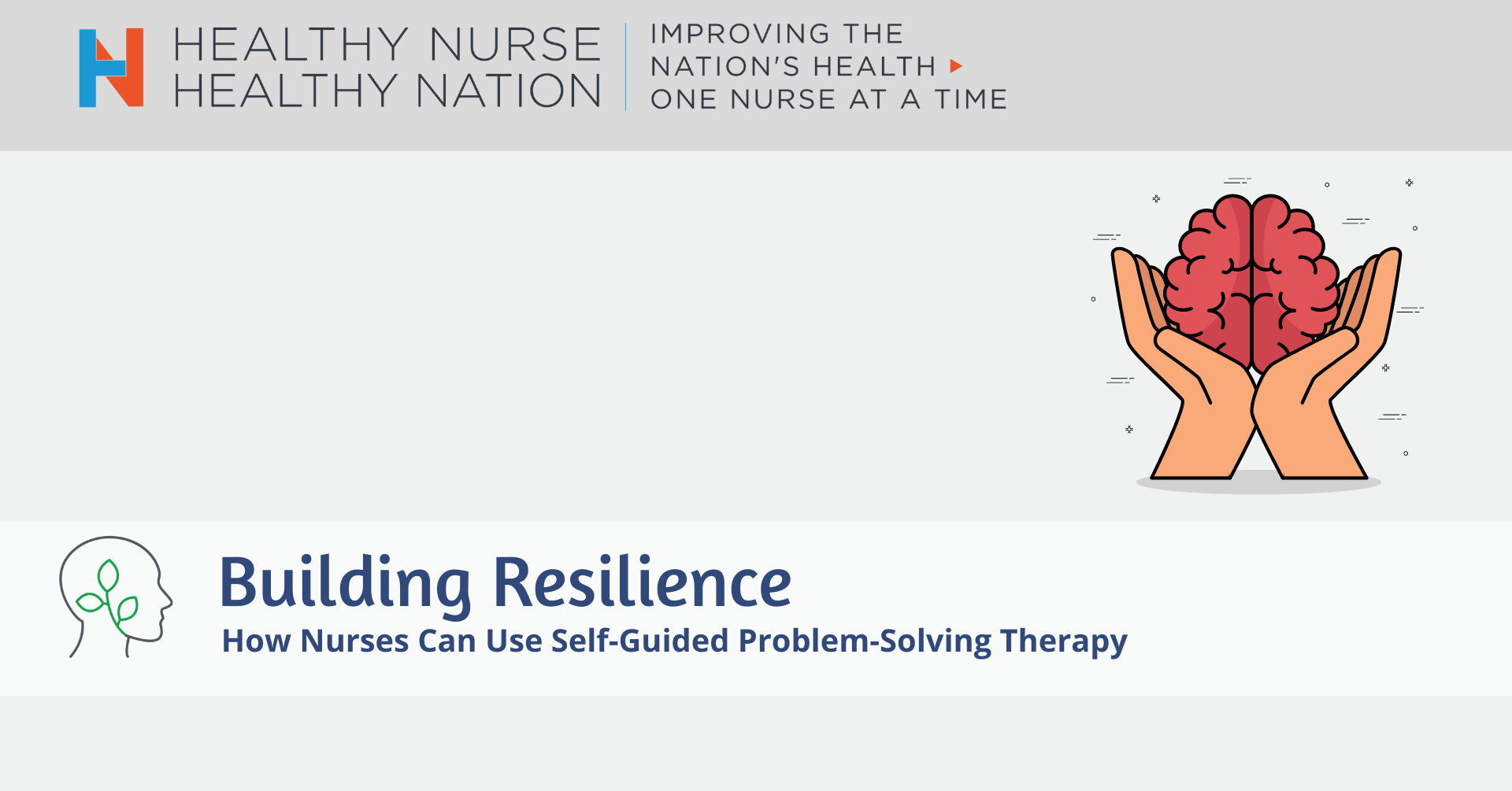How Nurses Can Use Self-Guided Problem-Solving Therapy To Build Resilience
Published
When you’re dealing with a difficult situation, does your reaction help get you through it, or make you more stressed?
The Transactional Stress Model says events themselves are not stressful, but our interpretation of these events is what causes stress.
“Stress is the physical and emotional response a person experiences when they feel an event’s demands outweigh their resources available to deal with the event,” says Marc C. Victorson, DNP, RN, AGCNS-BC, Strategic Services Associate of Nursing Quality at Duke University Hospital.
Learning how to change the way you cognitively cope with stressful situations builds resilience. You can do this through problem-solving therapy (PST), which increases your perceived resources and brings structure to your problem-solving skills. Typically taught during therapy, PST is a cognitive-behavioral intervention that helps you:
Why Should Nurses Use Self-Guided Problem-Solving Therapy?
While PST has been used by the Department of Defense for veterans and active-duty military for years, it’s also great for other demanding industries like nursing. Building resilience, which is defined as the ability to rebound from stress or prevent its occurrence in the first place, is imperative for any nurse who wishes to build a career in this field.
As a nurse, you may have coped with dying patients, pandemics, staffing shortages, long hours, violent patients or loved ones, and so much more. In the moment, these problems may have seemed insurmountable and that feeling may have resulted in enormous stress. However, you faced each problem you encountered with your team. You got through it. After each one, the powerful resources of your knowledge, training, and experiences continued to grow.
“Prolonged exposure to stress can lead to burnout — and problem-solving therapy counteracts stress,” says Dr. Victorson. “One of the greatest aspects we have for controlling stress and burnout is better understanding our own capabilities.”
In some situations, you can pause to contemplate the problem-solving process or ask for someone else’s input. In other situations, you don’t have time to pause and must act quickly, such as when you need to activate a code and initiate CPR. What makes PST great is you can either use it in the moment or in retrospective to help process the situation.
For example, let’s say you’re nervous about situations where you don’t have time to pause and think — what will you do? The answer is working through the problem-solving process before the event takes place. If you’ve thought it through and already know what you will do (like check pulse/breathing, activate emergency response, and initiate CPR), you will at least know when that situation occurs that you are doing all you can.
Dr. Victorson was a bedside nurse for many years working on general medicine, neuro step-down, and neuro ICU units. Early in his career, he experienced stress, burnout, and even panic attacks before he decided to address his problems and attend psychotherapy as a young nurse. After his time with a mental health provider, he saw his career in a new light.
“In my own experience, the vast majority of my worries were unfounded,” says Dr. Victorson. “There was nothing to be worried about because I was able to handle the situation and cope effectively.”

So, how do you know if problem-solving therapy could help you? If you’re experiencing signs of burnout or prolonged high stress due to issues that arise during your everyday, you could benefit from learning PST.
Burnout signs include:
To measure your own burnout, take the free Oldenburg Burnout Inventory.
Learning the Steps to Problem-Solving Therapy
The PST technique isn’t groundbreaking — you have probably done each aspect of it at some point in your life. What makes PST so powerful is that it brings all of these concepts together in a structured and near universal approach that’s practical, easily understood, and doable for the average person. You can use these skills in both your professional and personal life.
That said, this type of therapy is not something that comes naturally. It takes a conscious effort to follow it, especially when you’re fighting your automatic biological response to stress.
In situations that don’t require an immediate response (e.g., calling a code and initiating CPR), you can take even a short moment to problem solve. Follow the SSTA method:
Tips for Adopting a Positive Problem Orientation
Your thoughts, experiences, and overall problem-solving ability are your most important tools for addressing life’s problems. If you strengthen your mindset toward dilemmas from the beginning, you set yourself up for better problem-solving results.
Problems are going to happen in every part of life, especially in a challenging career like nursing. But the right mindset can get you through all sorts of challenges, including difficult patients, pandemics, family emergencies, bullying, etc., without having to feel unnecessary stress.
Dr. Victorson advises these guidelines to consider next time you face an issue:
If you’re still struggling with stress, make an appointment with your healthcare provider or contact a psychotherapist to discuss further options.
Tackling Practical Problems in Nursing
The longer you leave your problems unresolved, the more difficult it’ll be to solve them. Adopt a positive problem orientation so you can continuously tackle problems and challenging situations as they arise. By solving them right away, you’ll reduce your anxiety, stress, and burnout.
The more you practice self-guided problem-solving therapy, the more the steps will become second nature. You won’t have to deliberately think about the process — you’ll naturally approach problems in this way. Think of it as training your mind to respond to stressful situations. It’s going to take time to learn, but it’ll get easier each time.
What methods have you used to strengthen your problem-solving skills? How have they impacted your nursing career? Share with us.
For more information on problem-solving therapy, read this article from one of the developers of the therapy, Dr. Arthur Nezu, or explore these handouts that Dr. Victorson created for his doctoral project.

Not a member of Healthy Nurse, Healthy Nation (HNHN) yet? Join today!
Join our monthly challenges at hnhn.org/challenges
“Stress is the physical and emotional response a person experiences when they feel an event’s demands outweigh their resources available to deal with the event,” says Marc C. Victorson, DNP, RN, AGCNS-BC, Strategic Services Associate of Nursing Quality at Duke University Hospital.
Learning how to change the way you cognitively cope with stressful situations builds resilience. You can do this through problem-solving therapy (PST), which increases your perceived resources and brings structure to your problem-solving skills. Typically taught during therapy, PST is a cognitive-behavioral intervention that helps you:
- Embrace a positive problem orientation grounded in the belief that many problems are solvable
- Comprehend the role of emotions better
- Create a structured approach to problem solving which lowers psychological distress and improves well-being
Why Should Nurses Use Self-Guided Problem-Solving Therapy?
While PST has been used by the Department of Defense for veterans and active-duty military for years, it’s also great for other demanding industries like nursing. Building resilience, which is defined as the ability to rebound from stress or prevent its occurrence in the first place, is imperative for any nurse who wishes to build a career in this field.
As a nurse, you may have coped with dying patients, pandemics, staffing shortages, long hours, violent patients or loved ones, and so much more. In the moment, these problems may have seemed insurmountable and that feeling may have resulted in enormous stress. However, you faced each problem you encountered with your team. You got through it. After each one, the powerful resources of your knowledge, training, and experiences continued to grow.
“Prolonged exposure to stress can lead to burnout — and problem-solving therapy counteracts stress,” says Dr. Victorson. “One of the greatest aspects we have for controlling stress and burnout is better understanding our own capabilities.”
In some situations, you can pause to contemplate the problem-solving process or ask for someone else’s input. In other situations, you don’t have time to pause and must act quickly, such as when you need to activate a code and initiate CPR. What makes PST great is you can either use it in the moment or in retrospective to help process the situation.
For example, let’s say you’re nervous about situations where you don’t have time to pause and think — what will you do? The answer is working through the problem-solving process before the event takes place. If you’ve thought it through and already know what you will do (like check pulse/breathing, activate emergency response, and initiate CPR), you will at least know when that situation occurs that you are doing all you can.
Dr. Victorson was a bedside nurse for many years working on general medicine, neuro step-down, and neuro ICU units. Early in his career, he experienced stress, burnout, and even panic attacks before he decided to address his problems and attend psychotherapy as a young nurse. After his time with a mental health provider, he saw his career in a new light.
“In my own experience, the vast majority of my worries were unfounded,” says Dr. Victorson. “There was nothing to be worried about because I was able to handle the situation and cope effectively.”

So, how do you know if problem-solving therapy could help you? If you’re experiencing signs of burnout or prolonged high stress due to issues that arise during your everyday, you could benefit from learning PST.
Burnout signs include:
- Feelings of disengagement or exhaustion that you attribute to work
- Feeling like you’re just going through the motions or doing your job robotically
- Working solely for the paycheck and not for the fulfillment you originally got from the job
- Feeling irritable or short-tempered
- No longer enjoying getting to know patients
- Not trying to build rapport with patients and their families
To measure your own burnout, take the free Oldenburg Burnout Inventory.
Learning the Steps to Problem-Solving Therapy
The PST technique isn’t groundbreaking — you have probably done each aspect of it at some point in your life. What makes PST so powerful is that it brings all of these concepts together in a structured and near universal approach that’s practical, easily understood, and doable for the average person. You can use these skills in both your professional and personal life.
That said, this type of therapy is not something that comes naturally. It takes a conscious effort to follow it, especially when you’re fighting your automatic biological response to stress.
In situations that don’t require an immediate response (e.g., calling a code and initiating CPR), you can take even a short moment to problem solve. Follow the SSTA method:
- Stop: When you recognize you are experiencing emotional distress, you need to stop what you’re doing and employ your problem-solving skills. To do this properly, you need to become more aware of your body’s unique response to stress and sympathetic activation (e.g., tachycardia, tachypnea, headache, jaw clenching, or muscle tension) and use it as a sign that you are experiencing a problem. This is a crucial first step to prevent the out-of-control spiral called emotional dysregulation which prevents you from thinking clearly and properly solving your problem.
- Slow Down: Once you realize that your sympathetic nervous system is firing more than it should, you need to calm your racing heart and thoughts using stress reduction tactics like mindfulness. Take a few slow, deep, diaphragmatic breaths. This stimulates your vagus nerve and parasympathetic response to counteract your sympathetic nervous system. When you do this, try to focus solely on your breathing.
- Think: Consider the problem. Is it something you can solve? Is it significant enough to warrant your time and energy? If you answer yes to both, then come up with methods to solve problem. If the problem is too big for one solution, break it up into smaller pieces and generate solutions for each one of those. After generating solutions, weigh the pros and cons of each to identify the best one.
- Act: Implement the best solution you can come up with. If you find it difficult to find the motivation to carry out your best solution, try this thought experiment: What would occur if you do not address the problem; what would occur if you were successful in addressing the problem; and what would occur if you were only partially successful? Oftentimes we let problems fester and grow because we’re worried about failure. If we are even just partially successful, the outcomes may still be better than doing nothing. You might even learn something to better prepare yourself for a similar problem in the future.
Tips for Adopting a Positive Problem Orientation
Your thoughts, experiences, and overall problem-solving ability are your most important tools for addressing life’s problems. If you strengthen your mindset toward dilemmas from the beginning, you set yourself up for better problem-solving results.
Problems are going to happen in every part of life, especially in a challenging career like nursing. But the right mindset can get you through all sorts of challenges, including difficult patients, pandemics, family emergencies, bullying, etc., without having to feel unnecessary stress.
Dr. Victorson advises these guidelines to consider next time you face an issue:
- Problems are a normal part of life: You’ve been facing problems since you were a child. It’s part of being human and growing. If you didn’t face any challenges, life would be incredibly boring.
- Events themselves are not inherently stressful: The problems you faced in childhood hopefully don’t cause you stress anymore, but they were a big deal at the time. The same can be said of when you were a new nurse learning the ropes compared to where you are right now. The fact that not every problem causes stress, and what causes stress in one person may not cause stress in another, is because the event is not what causes the stress — it’s the interpretation of the event.
- Don’t view events as problems, but as challenges with something to gain: A problem is something negative that comes up unexpectedly and requires you to change the way you conduct yourself. If you view these events as a challenge with something to gain and recognize the reward for addressing them, it might lower the amount of stress you feel. Many of the challenges you face today are ubiquitous and will come up many times in your career. Learning to better overcome hurdles will allow you to be a more competent nurse in the future — and this is a tremendous reward in its own right.
- Focus on an attainable, yet ideal outcome: Try to visualize the benefits when you solve the problem. How will solving it make you feel? This mental approach is helpful because it reminds you of the positives that come from the end result. Thinking of your career this way, as the positives that result from addressing the challenges, brings you back to why you chose nursing in the first place. As the philosopher Friedrich Nietzsche, said, “He who has a why to live can bear almost any how.”
- Look ahead: Will the problem matter in a month? A year? 5 years? If the problem isn’t as important as you initially thought, turn your attention to something more worthy of your time and energy.
- Look back: After you experience stress, reappraise your situation and ask yourself: Were my initial worries warranted? If not, realize that your initial appraisal was incorrect — you need to have a healthier respect for your problem-solving resources.
If you’re still struggling with stress, make an appointment with your healthcare provider or contact a psychotherapist to discuss further options.
Tackling Practical Problems in Nursing
The longer you leave your problems unresolved, the more difficult it’ll be to solve them. Adopt a positive problem orientation so you can continuously tackle problems and challenging situations as they arise. By solving them right away, you’ll reduce your anxiety, stress, and burnout.
The more you practice self-guided problem-solving therapy, the more the steps will become second nature. You won’t have to deliberately think about the process — you’ll naturally approach problems in this way. Think of it as training your mind to respond to stressful situations. It’s going to take time to learn, but it’ll get easier each time.
What methods have you used to strengthen your problem-solving skills? How have they impacted your nursing career? Share with us.
For more information on problem-solving therapy, read this article from one of the developers of the therapy, Dr. Arthur Nezu, or explore these handouts that Dr. Victorson created for his doctoral project.

Not a member of Healthy Nurse, Healthy Nation (HNHN) yet? Join today!
Join our monthly challenges at hnhn.org/challenges
Blog Mental Health
08/24/2022 12:51pm CDT



Post a Comment or Question